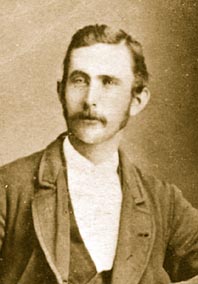
Peter Philip Carey AO is an Australian novelist.

Bushrangers were originally escaped convicts in the early years of the British settlement of Australia who used the bush as a refuge to hide from the authorities. By the 1820s, the term had evolved to refer to those who took up "robbery under arms" as a way of life, using the bush as their base.

Edward Kelly was an Australian bushranger, outlaw, gang leader and convicted police-murderer. One of the last bushrangers, he is known for wearing a suit of bulletproof armour during his final shootout with the police.
Jerilderie is a small, rural town in the northern Murray region of New South Wales, Australia. It is part of the Murrumbidgee Local Government Area. At the 2021 census, Jerilderie had a population of 922 people.

Ned Kelly is a 2003 Australian-British bushranger film based on Robert Drewe's 1991 novel Our Sunshine. Directed by Gregor Jordan, the film's adapted screenplay was written by John Michael McDonagh. The film dramatises the life of Ned Kelly, a legendary bushranger and outlaw who was active mostly in the colony of Victoria. In the film, Kelly, his brother Dan, and two other associates—Steve Hart and Joe Byrne—form a gang of bushrangers in response to acts of police brutality. Heath Ledger stars in the title role, with Orlando Bloom, Naomi Watts and Geoffrey Rush. The film received mixed reviews from critics and grossed $6 million worldwide.

Joseph Byrne was an Australian bushranger of Irish descent. A friend of Ned Kelly, he was a member of the "Kelly Gang" who were declared outlaws after the murder of three policemen at Stringybark Creek. Despite wearing the improvised body armour for which Ned Kelly and his gang are now famous, Byrne received a fatal gunshot during the gang's final violent confrontation with police at Glenrowan, in June 1880.

Glenrowan is a town located in the Wangaratta local government area of Victoria, Australia. It is 236 kilometres north-east of Melbourne and 14 kilometres from Wangaratta and near the Warby Ranges and Mount Glenrowan. At the 2021 census, Glenrowan had a population of 1,049.

The Kelly Gang is an Australian feature-length film about the Australian bush ranger, Ned Kelly. The film was released in 1920, and is the second film to be based on the life of Ned Kelly, the first being The Story of the Kelly Gang, released in 1906.

Daniel Kelly was an Australian bushranger and outlaw. The son of an Irish convict, he was the younger brother of the bushranger Ned Kelly. Dan and Ned killed three policemen at Stringybark Creek in northeast Victoria, near the present-day town of Tolmie, Victoria. With two friends, Joe Byrne and Steve Hart, the brothers formed the Kelly Gang. They robbed banks, took over whole towns, and kept the people in Victoria and New South Wales frightened. For two years the Victorian police searched for them, locked up their friends and families, but could not find them. Dan Kelly died during the infamous siege of Glenrowan.

Stephen Hart was an Australian bushranger, a member of the Kelly Gang.

The handwritten document known as the Jerilderie Letter was dictated by Australian bushranger Ned Kelly to fellow Kelly Gang member Joe Byrne in 1879. It is one of only two original Kelly letters known to have survived.

Justin Dallas Kurzel is an Australian film director.

Ned Kelly was a 19th-century Australian bushranger and outlaw whose life has inspired numerous works in the arts and popular culture, especially in his home country, where he is viewed by some as a Robin Hood-like figure.
The bushranger ban was a ban on films about bushrangers that came in effect in Australia in 1911–12. Films about bushrangers had been the most popular genre of local films ever since The Story of the Kelly Gang (1906). Governments were worried about the influence this would have on the population and bans against films depicting bushrangers were introduced in South Australia (1911), New South Wales and Victoria (1912).
J. J. Kenneally was an Australian journalist and trade unionist. An early populariser of Australian bushranger Ned Kelly and his gang via his book The Inner History of the Kelly Gang and Their Pursuers (1929), he was also one of the original members of the country's Labor Party and later formed his own party.

True History of the Kelly Gang is a 2019 bushranger film directed by Justin Kurzel, written by Shaun Grant, and based upon the 2000 novel of the same name by Peter Carey. A fictionalised account of the life of bushranger and outlaw Ned Kelly, the film stars George MacKay, Essie Davis, Nicholas Hoult, Charlie Hunnam and Russell Crowe.

In 1879, Australian bushranger and outlaw Ned Kelly devised a plan to create bulletproof armour and wear it during shootouts with the police. He and other members of the Kelly gang—Joe Byrne, Steve Hart, and brother Dan Kelly—had their own armour suits and helmets crafted from plough mouldboards, either donated by sympathisers or stolen from farms. The boards were heated and then beaten into shape over the course of several months, most likely in a crude bush forge and possibly with the assistance of blacksmiths. While the suits successfully repelled bullets, their heavy weight made them cumbersome to wear, and the gang debated their utility.

Francis Augustus ("Frank") Hare (1830–1892) was a British pioneer settler and police superintendent in the colony of Victoria, best known for his role in the capture of the notorious bushrangers known as the Kelly gang at the town of Glenrowan in north-west Victoria.
Ned Kelly is a 1959 Australian television play adapted from the radio play of the same name.
Hands Up, or Ned Kelly and His Gang is a 1900 Australian play by Edward Irham Cole about Ned Kelly.
















